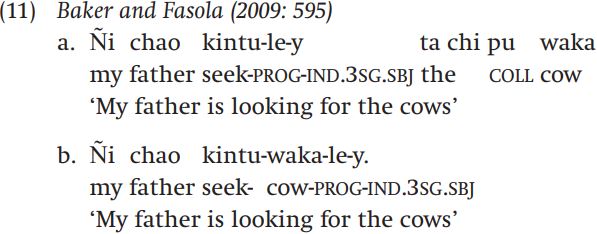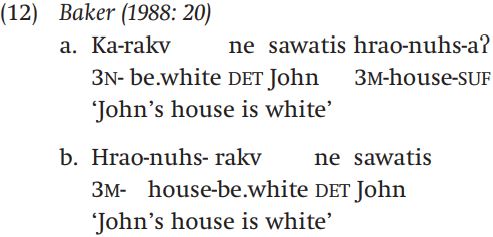


 Grammar
Grammar
 Tenses
Tenses
 Present
Present
 Past
Past
 Future
Future
 Parts Of Speech
Parts Of Speech
 Nouns
Nouns
 Verbs
Verbs
 Adverbs
Adverbs
 Adjectives
Adjectives
 Pronouns
Pronouns
 Pre Position
Pre Position
 Preposition by function
Preposition by function 
 Preposition by construction
Preposition by construction
 Conjunctions
Conjunctions
 Interjections
Interjections
 Grammar Rules
Grammar Rules
 Linguistics
Linguistics
 Semantics
Semantics
 Pragmatics
Pragmatics
 Reading Comprehension
Reading Comprehension|
Read More
Date: 2023-11-25
Date: 2023-10-18
Date: 2023-09-11
|
There is one more way in which morphology interacts with the argument structure of verbs. Consider the data in (11) from the Araucanian language Mapudungun:

Sentences (11a) and (11b) mean precisely the same thing in Mapudungun. In (11a), the direct object ‘cow’ is an independent noun phrase in the sentence, but in (11b), it forms a single compound-like word with the verb root ‘seek’. This sort of structure – where the object or another argument of the verb forms a single complex word with the verb – is called noun incorporation. Noun incorporation tends to occur in languages with polysynthetic morphology (see section 7.4). In Mapudungun, the object noun follows the verb root in both the incorporated and the unincorporated forms. But this need not be the case, as the example in (12) from the Iroquoian language Mohawk shows:

As (12a) shows, the direct object follows the verb when it occurs independently in Mohawk, but it precedes the verb when it is incorporated.
There is much discussion among morphologists and syntacticians whether noun incorporation should be explained as a result of morphological rules or syntactic rules.
|
|
|
|
لخفض ضغط الدم.. دراسة تحدد "تمارين مهمة"
|
|
|
|
|
|
|
طال انتظارها.. ميزة جديدة من "واتساب" تعزز الخصوصية
|
|
|
|
|
|
|
مشاتل الكفيل تزيّن مجمّع أبي الفضل العبّاس (عليه السلام) بالورد استعدادًا لحفل التخرج المركزي
|
|
|